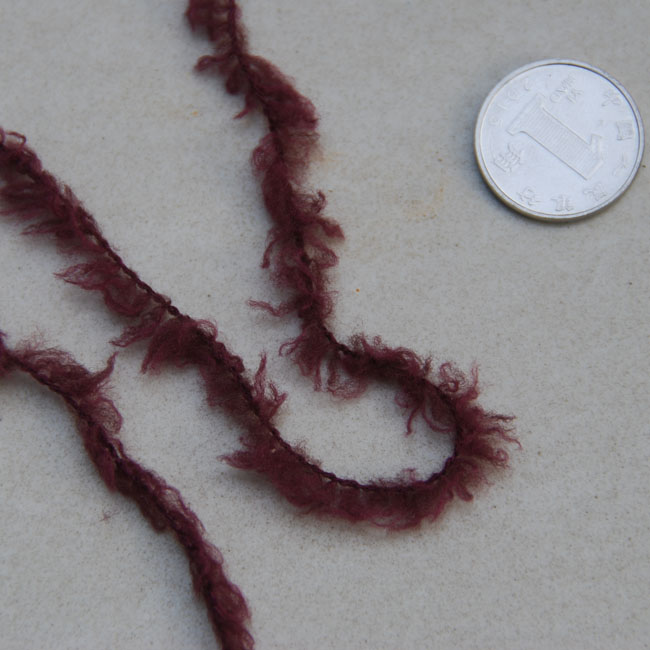Application of fancy yarn in fabric
Fancy yarn is a general term for fancy yarn and fancy yarn. It refers to the yarn produced by special processing technology, which has irregular or regular changing characteristics in appearance and structure, and is different from ordinary single yarn and ply yarn. In practice, it is customary to call single fancy yarn fancy yarn, and composite fancy yarn fancy yarn fancy yarn. As a common branch of yarn, fancy yarn has been widely used in various fields of textile industry because of its novel structure, colourful appearance and easy to play a new role.
Fancy yarns are classified as knot yarn, belly yarn, corrugated yarn, loop yarn, slub yarn, wrapped yarn, Icelandic wool yarn, tufted yarn and braid yarn.
The Use of Fancy Yarn in Fabrics
There are two ways to use fancy yarn in knitting process. One kind of fancy yarn is used for warp and weft yarn, or full warp or full weft yarn, which is more used in weaving thick, stiff and thick fabric. In particular, some irregular fancy yarn outlines make the irregular distribution of fabric surface more common style, such as cotton and hemp yarn fabrics: warp 133Tex pure ramie slub yarn, weft 54.4Tex*2 grey hemp and cotton yarn, plain weave arrangement. Generally speaking, fewer fancy yarns are used for warp and weft. Because of the more decorative cloth surface, there is no rough and concise feeling, but it is too messy. The problems of overweight cloth surface and low knitting power appear, and the production cost increases. The second is to place fancy yarns and general yarns in a certain proportion in warp and weft yarns, adjust the density of warp and weft, and adorn fancy yarns in fabrics to make them have special appearance and outstanding wearing functions. Based on the principle of less and more refined, they play an outstanding role in stereoscopic sense without excessive increase in cost. The knitting process is also more convenient, and the production power is advancing, such as silk knot silk, warp 23 dtex*3 factory silk, A weft 23 dtex*4 factory silk 8 twist/cm, B weft (23 dtex*3+23 dtex*3 color yarn) 4.65 twist/cm real silk knot yarn, A weft and B weft are arranged to spin small jacquard with longitudinal stripes and knot yarns outside. The lattice effect of decoration.

The planning methods of fancy yarn woven fabrics include: using fancy yarn and other warp and weft fabrics with different functions and thicknesses to make the appearance of fabrics into stripes, lattices, dots, brightness, concave and convex stripes; using warp and weft color lines and fancy yarn to mix can form a three-dimensional effect of color change; using the ratio of warp and weft to fancy yarn placement. The changes make up the common appearance; use different warp and weft densities to adjust; use different fabric arrangements and fancy yarn blending; use a variety of finishing and dyeing characteristics to advance the function and quality of fancy yarn fabrics. It is worth noting that in order to reflect the color effect, structure effect and special effect of fancy yarn on the final appearance of the fabric, attention should be paid to the material allocation, pattern type and fabric use.
Fancy yarn has made great progress in the development and application of fabric products after years of efforts. Using fancy yarn on top of worsted fabrics can not only uphold the high-grade feeling of worsted fabrics, but also make the appearance of the fabrics slightly gaudy in quiet. The same woolen fabrics can be used in rough fabrics to produce the best-selling woolen fabrics. In yarn-dyed products, fancy yarn is the most widely used. Thick, medium and thin fabrics are all used fancy yarn. In addition, the use of imitation natural fiber products and fancy gauze is also becoming more sophisticated.
The article originates from: fancy thread manufacturer
-
07-11
Introduction of spinning technology of Crocheted feather fancy yarn
In the spinning process of Crocheted Velvet Fancy yarn, besides some characteristics of traditional fancy yarn, Crocheted fancy yarn has the advantages of novel appearance, no hairing and no looping
-
07-11
The difference between fancy yarn and composite yarn
Composite yarn is only one kind of fancy yarn. Fancy yarns have a wide range of sizes, including many types of yarns. In Abstract terms, besides traditional ring spinning, walking spinning, air spin
-
07-11
Application of nylon yarn
Although non-dyed nylon yarn (nylon yarn) has been developed for many years and its use and production are not large, it will be more and more accepted by the market because of its green production
 Hotline:0750-6402010
Hotline:0750-6402010